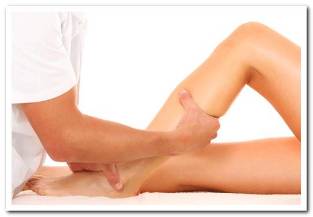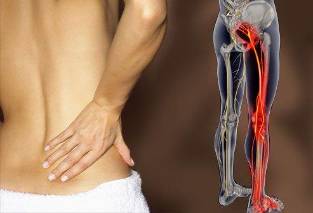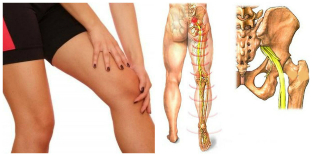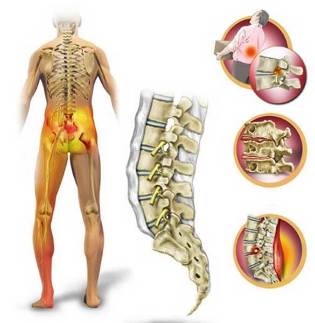This is the type of pain interferes not only live, but also to walk. How is it that the pain arising in the back, which can penetrate into the body and cause lameness? Although the source is much greater we feel his influence on this distance: the back is sore, but numb and drag their feet. How the back pain radiates into the leg?

Causes radiating pain in the legs can be draft, low back pain, hernias, tumors, and stress
This is due to a reflex nervous nature of pain, its ability to spread throughout the entire length of the nerves arising from the spinal cord. If this nerve somewhere is irritated, is a distant response.
One of the possible causes of foot pain can be inflammation of the nerve sciatic
The lumbosacral plexus is the nerve fibers, which arise from the vertebrae l4, L5 and S1 — S3. This plexus is called the sciatic nerve. From the comfort of your piriformis, it literally splits at the thigh and ankle muscles and joints, with the most powerful and longest nerve in the human body.
Sciatica responds as in the lower extremities. Pain appeared in the lower back to the legs, is called lumbosciatica. Usually suffers (is ill or pulls) one foot on the side of the nerve, but it happens and a two way reaction in which both feet hurt.
The pain is not limited to, the patient stalking and other unpleasant feelings:
- Kolyat feet, lose sensitivity, pulling or numb
If the nerve is affected at the level of the sacrum, through the muscles of the buttocks and thighs, pain, syndrome from the sacrum to the foot, is called sciatica.
Very often people feel pain in the back and legs, in two different categories and I don't see the root cause. "I have a pain in my right knee, numb feet. I can't get on foot and climb a flight of stairs," — is a detailed description of the status of your own limbs, forgetting about the pain in the back, all in front of her. Surprised also, "incompetence" doctors, who, instead of treating osteoarthritis of the knee, all of a sudden started to work together the spine.
But it is the spine, with its complex nervous, muscle-ligament and the vascular system is the root cause for sciatica.
Why get sick, pull and numb feet
- Normal draft can be a cause of lumbago in the lower back, radiate to the legs. To the same legal consequences that can result from sitting on a cold surface swimming in cold water, and similar reasons. All of them can be grouped under the term "hypothermia"
- Osteochondrosis — dystrophic degenerative process in the lumbosacral region also occasionally causes a sharp pain, radiate to the limbs. The deformation of the disk touching the nerve fibres and causes inflammation
- The formation of protrusion and herniated discs can cause pain, syndrome is very high intensity, if is the compressed nerve. Pain in the impulse, which is divided in the area of innervation by the speed of the flow. I wonder what is the feeling on the affected side also similar to the symptoms of low flow: Tingling, burning, crawling skin crawling, feeling cold. These symptoms are called paresthesia. If the legs no longer hurt, and just numb, it could mean that because long-term compression of nerve fibers, began the atrophic processes
- Other diseases (spondylitis, spondylosis, spondylolisthesis) leads to limitation and stagnation in the bones, tissues, muscles, nerves and blood vessels, which promotes inflammatory processes
- Tumors of the spine and tuberculosis, can also cause inflammation of the sciatic nerves, and the feeling that pulls and numb extremities
- Stress is not a harmless phenomenon and never goes unnoticed, especially where nerves are involved
The classification of the syndrome of pain in the back and legs,

In its origin of all types of pain in the back, radiate to the extremities, can be roughly defined into three main groups:
- The first group is associated with the neuroreflex the nature of the pain syndrome and pathological processes in the spine.
Here you can put all the DDP (degenerative processes), due to which it is violated all metabolic processes in the tissues and their diet, and infectious, inflammatory diseases and congenital dysplasia of the spine. The threat to the nerve fibres here is twofold:
- They are exposed to direct mechanical effects of parts of the spine
- Degenerative changes begin to occur in nerve fibers
- The second group, which is associated with a muscle disorder in the back or legs. Causes it to turn otherwise. This:
- Scoliosis of the spine, where it formed a persistent asymmetry of muscle groups, located on both sides of the bow
- Increased loads of certain muscles, due to unpleasant situations, or physical stress
- Muscles myositis due to hypothermia, infectious processes, or congenital anomalies
- Leg pain often occurs at a very banal reason — walking in high heels Cause foot pain can be uncomfortable shoes with high heels
- Autonomic dysfunction — a third of the species the origin of sciatica
Vegetative-visceral disorders — this is a huge symptom, which includes all the disturbances in the internal organs and body systems related to impaired correction of the autonomic nervous system (ANS)
The autonomic system is closely connected with the Central principle of direct and feedback:
- Defects in the Central nervous system, local damage to the spinal nerves and fibers cause irregularities in the VNS
- Autonomic disorders include the response of the nerves and the Central nervous system, in the area of innervation, which are
Especially often problems with the feet can occur when vegetative-vascular disorders in the area of the lumbosacral spine. Poor blood flow can cause pain in the back and limbs, muscular dystrophy of the legs.
To summarize the above, we can conclude:
If you want to know why is sick, the pull and numb feet, because it is pain originating in the back, only after a thorough diagnosis:
- History
- X-ray, CT and magnetic resonance imaging of the spine
- Angiography of the
- Laboratory studies, etc ..
Treatment of pain in the back and legs,
The treatment shall be fully suitable for causing the disease.

- If the pain generated by the PROPOSED, that is:
- Painkillers and anti-inflammatories (nsaids)
- Traction techniques (stretching of the spine to the exhaust of the device)
- Chiropractic and acupuncture
- The use of low frequency currents, magnetic therapy and other physiotherapy methods hardware
- Exercises physical therapy
- With muscle disorders that are caused by scoliosis, additionally apply:
- Specific corrective exercises
- Wearing corsets
- Treat myositis successfully carried out:
- Irritating ointments (if myositis is not caused by infection)
- Massage, physical therapy
- In some cases, you may need antibiotic therapy
- With dystonia of prescribed complex treatment:
- Vasodilators
- Angioprotectors
- Vitamins and stimulators of metabolic processes
- Sedatives sedatives
Treatment reflect pain is always a time consuming process, because it usually appears in the chronic long-term diseases that affect the human nervous system
So if it is in the back, try to immediately determine the cause of the pain and start the treatment without waiting for the moment when you start to hurt, go numb or pull the leg.
If pain radiates into the leg, first think about lumbago (sciatica) or sciatica. Especially if your fingers go numb and my leg pain. The most common example. And few people remember that these symptoms can be and at other diseases, such as acute appendicitis.

Reasons
- The most common cause is pathology of the spine (osteochondrosis, scoliosis, radiculitis, sciatica, disc herniation, spondylitis, spondylolisthesis and other diseases of degenerative nature, as well as post-traumatic complications, tumours and infection);
- Pathology of the organs of the lower part of the abdomen (kidney stones, cystitis, oophoritis, adhesions, inguinal hernia, appendicitis, etc).
Important: On rare diseases, which leads to a phenomenon described the syndrome, should not be forgotten.
Pathology of bone and muscular structures
Pain in the lower back, which is associated with disease of the spine and extends to the lower limb, which is called lumbosciatica.
Degenerative process in the lumbar spine, the pain often develops due to compression of the nerve root and radiates to the lower extremities on the main nerve of the lumbosacral plexus, the sciatic, is divided into the fibular and tibial. The latter gives the popliteal fossa climb to the nerves of the lower leg.
Compression of the nerve roots, which occurs when the destruction of the intervertebral cartilages, on the basis of the degenerative reactions. This reduces the distance between the adjacent vertebrae and, consequently, the less openings for the spinal nerve roots. When a herniated, they interfere directly with the protrusion of the hernia, in tumors, abnormal tissue growths, while spondylosis is bony overgrowths, called osteophytes.
On the background of the pathological process is always evolving inflammatory reaction in the form of edema and disruption of the surrounding tissues, worsening the flow of blood in the affected area, inhibiting normal metabolism. Resulting increased muscle tone in the area of innervation of the roots of the disadvantaged, which leads to a strengthening of the pain.
The development of changes in the spine, usually marked with the end of the process of ossification of approximately 25 years and is considered a normal physiological phenomenon. This early aging of the bones and the cartilage structure, which can be withdrawn if you follow the principles of proper nutrition and strengthen the back muscles with specific exercises.
The various features of the pain syndrome
Diseases of the spine occur in the following types of sciatica:
- Musculo-tonic — conveys a strong, sharp spasm, while the development of a compensatory curvature of the spine, movement in the lower back limited;
- Autonomic-vascular — pain, burning in nature, accompanied by a feeling of numbness in the foot, you may receive a feeling of coldness and heat in the limbs, especially when you want to change the position of the body. So a responsive vascular system in pathological process;
- Neurodystrophic — develops burning cramps mostly at night, sometimes the skin above the pathological foci, thick.
Important: the most common pain syndrome is mixed. One form of sciatica, in its pure form is rare.
Clinical manifestations of some diseases of the spine
- When osteoarthritis pain can be acute or chronic. Acute pain occurs when sudden movements or lifting heavy weights. It is often so numb feet have pain in the area of the hip joints, and movement in the lower part of the back is severely restricted.
Chronic pain is almost a constant companion of life, which almost uses, such as the lucid interval is very small. So it pulls in the lumbar region and along the branches of the sciatic nerve.
- When a herniated, localized in the lumbar spine, the pain may not be at all, but a dysfunction of the organs of the pelvis: often pulls a "pee in toilet", can develop incontinence, it should be noted in the legs, tingling and "pins and needles".
With the development of a pain syndrome may develop paralysis of the lower limbs, caused by a complete compression of the motor rootlets. But more for both the serious consequences of a pathological process, not get.
- With sciatica lumbago in the lower back radiates into the leg, so is lameness, muscle aches and pulls. You can reduce the sensitivity on the posterolateral surface of the leg and on the back side of the foot. Relief comes in the supine position, the back must be relaxed. Sometimes the pain syndrome is reduced in the "fetal position".
Pathology of the internal organs
Often the pain in the low back radiating to the legs, are a manifestation of diseases of internal organs. Ud, while this numbs, the nerve, to pull, and the pain may also be given in the groin.
- Kidney stones can manifest described the syndrome when the stone goes through the ureter;
- And adhesive disease of the nerves, the pressure spikes;
- Salpingoophoritis, uterine fibroids, endometriosis also manifest as discomfort in the lumbosacral segment and the leg on the affected side;
- Acute appendicitis with atypical location of the Appendix (retroperitoneal on the posterior surface of the cecum) pulling pain in right lumbar region, which shoots down my right leg. If in the supine position, try to lift your straight right leg that was accidentally bent and is developed externally.
These phenomena are explained the peculiarities of the innervation of the pelvic organs and legs.





































